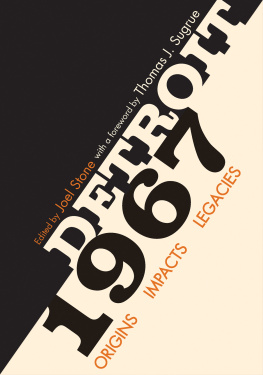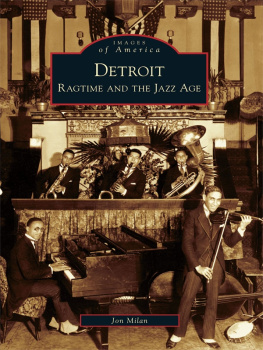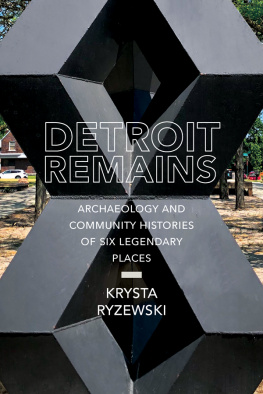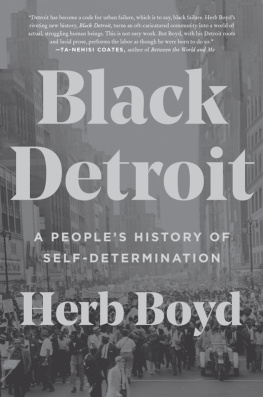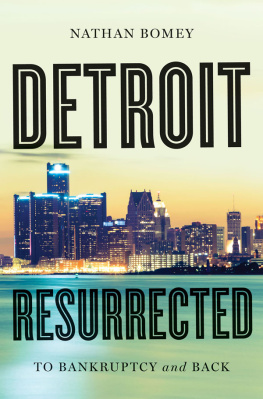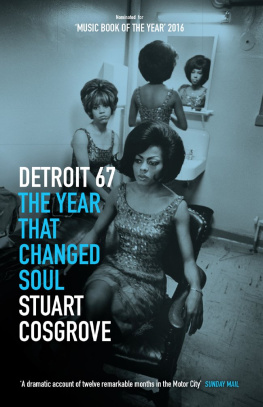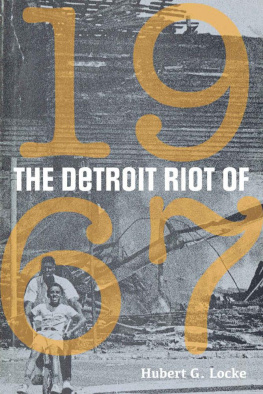
2017 by Wayne State University Press, Detroit, Michigan 48201.
All rights reserved. No part of this book may be reproduced without formal permission. Manufactured in the United States of America.
ISBN 978-0-8143-4303-6 (jacketed cloth); ISBN 978-0-8143-4304-3 (ebook)
Library of Congress Cataloging Number: 2017933721
Designed and typeset by Andrew Katz
Wayne State University Press
Leonard N. Simons Building
4809 Woodward Avenue
Detroit, Michigan 48201-1309
Visit us online at wsupress.wayne.edu
Contents
Foreword
Thomas J. Sugrue

No day figures more prominently in the history of modern Detroit than July 23, 1967. Early that morning, the Detroit Police Department decided to bust a blind pig, an illegal after-hours bar on 12th Street, then one of black Detroits most prominent business districts. Rather than making a handful of arrests and dispersing the revelers, the police officer who directed the raid decided to arrest all eighty-five people present. By four in the morning, an hour after the bust, nearly two hundred had gathered to watch the proceedings. As the arrestees shouted allegations of police brutality, tempers rose. The crowd began to jeer and to throw bottles, beer cans, and rocks at the police. William Scott III, a son of one of the blind pigs owners, threw a bottle at a police officer and shouted, Get your goddamn sticks and bottles and start hurtin baby. By 8:00 a.m., a crowd of over three thousand had gathered on 12th Street.
Over the next several days, looting and burning spread over nearly one hundred square miles of the city. Aerial photographs showed the Motor Citys sky shrouded in smoke. Property damage, still visible in vacant lots and abandoned buildings in Detroit, was extensive. Rioters damaged 2,509 buildings; $36 million in insured property was lost.
By the end of the week, more than seventeen thousand law enforcement officers and troops, including five thousand members of the US Armys elite 101st Airborne, had deployed in the city; 7,231 men and women were arrested on riot-related charges; forty-three people died, most at the hands of the citys police force and the Michigan National Guard. The police were especially brutal, beating arrestees and in one case vandalizing and firebombing a black-owned shop. Three police officers, responding to rumors of sniping, raided the citys Algiers Motel and executed three young black men on the premises, none of them participants in the uprising.
To many observers in 1967, Detroit seemed a most unlikely location for a mass uprising. Detroit had established a reputation in the 1960s as a model city in mitigating racial antagonism. Jerome Cavanagh, Detroits mayor since 1962, was lauded as an effective urban leader who had a future in national politics. The Cavanagh administration was especially effective in tapping into the largesse of Johnsons Great Society. Detroits urban planners delivered grant proposals to Washington, DC, sometimes only hours after new programs were announced. Detroit was indeed on the front line of the War on Poverty, receiving more federal funds than every city but New York and Chicago between 1964 and 1967.
But those who were surprised by Detroits uprising were blind to the citys long and troubled history of racial and economic inequality. In the preceding quarter century, whites had vandalized the homes of more than two hundred African American families who were the first or second to move into formerly all-white neighborhoods. In a massive grassroots movement, white homeowners formed hundreds of neighborhood organizations with the sole purpose of keeping their neighborhoods racially pure. Detroit ranked near the top of the nations most racially segregated cities.
The gap between black and white incomes in Detroit remained substantial throughout the 1960s. About 19 percent of Detroits African American population lived beneath the poverty line. As was the case in other large American cities, Detroits neighborhoods and schools were highly segregated. Police-community relations in the Motor City were poisonous, the result of decades of systematic harassment of African American civilians and countless incidents of police violence against blacks suspected of committing a crime. Hundreds of files tucked away in the papers of the Detroit branch of the National Association for the Advancement of Colored People from the middle of the twentieth century document the indignities and dangers of walking and driving while black in the city, from police officers shouting racial epithets to stopping, frisking, and beating young black men who were in the wrong neighborhood at night.
Detroit experienced the most violent uprising of the 1960s, but what happened in the Motor City had counterparts all over the United States. The same summer that Detroit exploded, 163 other towns and cities burned, ranging from Newark, New Jersey, where thirty-four were killed, to little Wadesboro, North Carolina, with a population of a little more than a thousand. Riots erupted in suburban Plainfield, New Jersey, in inner-city Buffalo, New York, and in troubled Cairo, Illinois.
What happened in Detroit and other cities can be understood only in the broadest historical context. The clashes on the citys streets reflected a long, unresolved history of racial conflict, much of it submerged beneath historical consciousness. Many people perceived the Norththe region where most of the 1960s black uprisings occurredas somehow immune from the nations troubled racial past, overlooking the fact that the region had its own history of slavery, systematic racial exclusion, and white-on-black violence over housing and education. Through the middle of the twentieth centuryuntil civil rights protestors raised their voices in oppositionmetropolitan Detroit had Jim Crow restaurants, hotels, bowling alleys, swimming pools, and amusement parks. Despite the valiant efforts of trade unionists to open up Detroits factories to black workers, racial discrimination persisted on the citys assembly lines through the 1960s. Detroits skilled tradesin the auto and construction industrieswere nearly all-white. Some black activists considered Detroit to be the nations northernmost southern city, a bitter description of a place where the promise of racial equality was still a distant dream despite the rhetoric of color blindness and racial inclusion.
Detroits 1967 riot is conventionally portrayed as a moment of collective lawlessness and disorder or as an irrational outpouring of rage. Those descriptions are woefully inadequate. The events in late July were an outgrowth of years of protest. To use the contested language of the 1960s, black Detroiters engaged in an uprising against a racially unequal status quo, a rebellion against brutal police and exploitative shopkeepers. There is no evidence that the burning, looting, and vandalism that happened on the citys streets in July 1967 was organized, despite pervasive conspiracy theories that outside agitators, whether communists or advocates of black power, had orchestrated the riot. But there is abundant evidence that many of those who took to the streets saw their actions as a challenge to the legitimacy of white authorities. Many of the participants in the 1967 riot took the opportunity to exact revenge for economic hardship. Looters singled out merchants, especially owners of food stores who routinely overcharged their inner-city customers. Some saw looting as redistributive justice.
Like all rebellions, Detroits had unanticipated consequences. Few who took to the streets had a vision for what the postriot city would look like. In the aftermath of July events, Detroits civic leadershipfor a timechanneled money into community economic-development projects. Foundations sponsored job training and creation programs. City officials haltingly implemented programs to diversify the public employee workforce, even though they faced fierce resistance, especially among the citys overwhelmingly white police force. But the long, hot summer also fueled an already intense, bipartisan demand for tough law and order politics, including militarizing police departments and expanding the prison system. The fallout from the urban uprisings also gave whites who had long fiercely opposed housing and educational integration a new justification for keeping blacks out of their neighborhoods and schools. Half a century after 1967, Detroit remains near the top of the list of Americas most racially divided metropolitan areas. Many whites continue to rally around calls for tough policing and continue to discount African American grievances as special-interest pleading.
Next page
